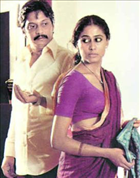Tarang
Year: 1984
Writer/Director: Kumar Shahani
Cast: Amol Palekar, Smita Patil, Shreeram Lagoo, Rohini Hattangadi, Om Puri, Kawal Gandhiok
(Read original article on PFC)
If you want to know why the so-called Parallel Cinema movement in Hindi cinema died down in the 1980s, then go and watch this movie- at your peril of course! The only reason I saw it was to listen to Lata Mangeshkar’s superb rendition of ‘Sang so jaao’- a complex Vanraj Bhatia composition that appears almost at the end of the film!
Looking at the stalwarts featuring in the film’s cast, is it too much to expect a decent fare? But all we come across is just a rambling, incoherent and at times incomprehensible narrative that fails to hold interest.
Story-line: An aging industrialist (Shreeram Lagoo) is trying to run his troubled company by maintaining a delicate power balance. Views of his son-in-law (Amol Palekar), who is actively running company’s day-to-day business, are in constant conflict with his foreign-based son (Girish Karnad). The worker-union trouble is a major issue and management-backed faction is trying its best to undermine the workers’ interests. To complicate the matters, the industrialist’s only daughter (Kawal Gandhiok) is mentally instable and prone to mood-swings. Her young son is in the care of a housemaid (Smita Patil), who happens to be a homeless widow of a Union leader.
Using these ingredients, this patchy story tries to cover a big canvas of the power struggle within an industrialist family, the worker- union movement, the all-pervading corruption in society, the rich versus poor struggle and the emotional turmoil of the people involved. Unfortunately the brush- strokes painting on that canvas prove weak and colorless.
Amol Palekar as the suave, crooked, new breed businessman and Smita Patil as his intelligent, loyal and yet gullible maidservant are the main protagonists in this film. They represent the rich and the poor. Their chemistry, their conflicts and their complexities form the crux of the story. Their performances are natural and nuanced as expected but even they cannot get over the overall tedium of the proceedings!
On the net, I came across a raving review from a foreign critic that opines: “Tarang is not easy to assess, nor will it ever be received by the general audience with understanding or enjoyment. It is slow, larger than life, and undoubtedly intriguing.” In the same review, there are comments from Shahani that tell us that Tarang was his exploration of the epic form of cinema. (Read that review here.)
I found Shahani’s direction too hard to fathom. Within this so-called realistic storyline, he suddenly lapsed into realms of fantasy. Even he decided to end the film on a fantasy-filled note. These detours were as unconvincing as they were unexpected. Most importantly he failed to keep up the momentum and let the film meander into an unending drag. ‘Tarang’ left me with questions- not about the moral or social issues that the film tried to touch but about my own sanity for having braved through those tormenting tortuous two and a half hours!
I feel that films like Tarang, No Smoking, Saawariya or Delhi 6 belong to the same category where the director had some supposedly great concept in his mind but then failed miserably to translate his vision onto the silver screen. These directors (and their supporters) may argue that people couldn’t understand their artistic vision or that the audience was too dumb! But what is the use of making a film for a public release if it is understood by only a handful? It is not just some meaningless home video to be enjoyed by the few family faithful. Forget the commerce part of it, but doesn’t even the artistic value of such ventures suffer when the directors opt for such boring, complex and undecipherable cinematic language?


